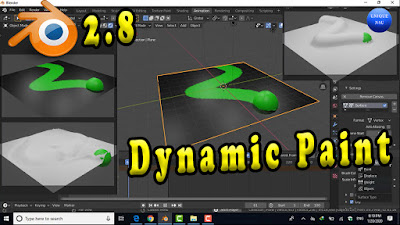Dynamic Paint Tutorial in Blender 2.8 2020 for beginners
Blender 2.8 Dynamic Paint 3D Simulation - Physics Tutorial for beginners Complete Step by Step.

Dynamic Paint and Brush
First panel of canvas contains the list of Dynamic Paint surfaces. These surfaces are basically layers of paint, that employment independently from each other . you'll define individual settings for them and bake them separately. If surface type/format allows previewing results in 3D View, an eye fixed fixed icon is visible to toggle preview. The checkbox toggles whether surface is active within the least . If not selected, no calculations or previews are done. You can also give each surface an unique name to easily identify them. Below you'll set surface type and adjust quality and timing settings. Each surface features a certain format and sort . Format determines how data is stored and outputted. Currently there are two formats available: Image Sequences. Dynamic Paint generates UV wrapped image files of defined resolution as output. Vertex. Dynamic Paint operates directly on mesh vertex data. Results are stored by point cache and should be displayed in view ports. However, using vertex level also requires a highly subdivided mesh to work . From quality settings you'll adjust image resolution (for image sequences) and anti-aliasing. Then you'll define surface processing start and end frame, and number of used sub-steps. Sub-steps are extra samples between frames, usually required when there is a really fast brush. From the first brush panel you'll define how brush affects canvas color surfaces. Absolute Alpha limits brush alpha influence. Without it, brush is “added” on surface over and once more each frame, increasing alpha and thus influence of coat canvas. In many cases however, it’s preferred to not increase brush alpha if it already is on brushes level. Erase Paint makes brush dissolve exiting paint instead of adding it. Wetness defines how “wet” new paint is. Wetness is visible on “Paint” surface “wet map”. Speed of “Drip” and “Spread” effects also depends on how wet the paint is. Use object material When enabled, you'll define a cloth to be used as brush color. This includes material’s base color and each one textures linked thereto , eventually matching the rendered diffuse color. This setting is simply available when using “Blender Internal” render at the moment . Wave Type Select what effect the comb has on the wave simulation. Depth Change makes brush create waves when the intersection depth with the surface is modified thereon point. If the comb remains still it won’t have influence. Using a negative “Factor” with this type can create a pleasing looking “wake” for moving objects like ships. Obstacle Constantly affects surface whenever intersecting. Waves also are reflected off this brush type. However, due the character of wave simulation algorithm this type creates an unnatural “dent” within the surface if brush remains still. Force Directly affects the speed of wave motion. Therefore the effect isn't one to a minimum of one with brush intersection depth, yet the force strength depends thereon . Reflect Only type has no visible effect on the surface alone but reflects waves that are already on the surface. Factor adjusts how strongly brush “depth” affects the simulation. you'll also use negative values to make brush pull water up instead of down. Clamp Wave in some cases the comb goes very deep inside the surface messing whole simulation up. you'll use this setting to “limit” influence to only certain depth.
Video Watch on YouTube
Screen Shots
Simulation important Points:
Dynamic Paint
1.Canvas
2. Brush
2. Brush
Shading Nods
1. Attribute
Download Instructions
1. Click below download link
2. Skip ad
3. chnage WWW1. to WWW4.
Blender File Download Link







No comments:
Please do not enter spam Links and Comments.